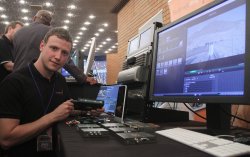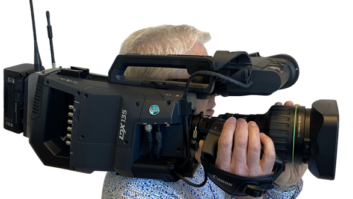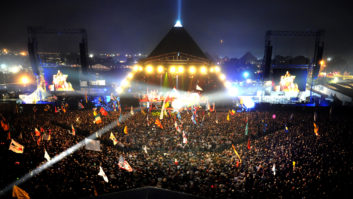
One of television’s hottest technology developments of the past couple of years is the external recorder – new form factors offering a flexible way of making high bit-rate, tapeless recordings from almost any camera on the market. David Fox reports on this tapeless boom.
There are several low-budget cameras that can record great HD pictures – just not on the recorders they come with. The BBC, for example, has qualified cameras such as the Panasonic AF101 and Sony PMW-F3 as HD only when they are used with an external recorder. Fortunately, there have been a lot of on-camera recorders launched in the past year offering higher quality, tapeless recording, making use of the HDMI or SDI connectors that bypass the camera’s own compression systems.
The key reasons for adding on a recorder, according to Mike Schell, president of Convergent Design, are: “quality improvement over native camera codec”, going from 4:2:0 to 4:2:2 and 25/35Mbps to 50/100Mbps compression (or better); the “transition to tapeless workflow” – there are “still lots of tape-based cameras which are being upgraded with an external recorder (HDCAM, DVCPro HD) to enable tapeless workflow and improve video quality”; PoV cameras, which all require external recorders (Toshiba, Iconix, etc) – the BBC’s Top Gear uses the nanoFlash for all of its in-car recording; and to “standardise workflow – one recorder can be used across multiple cameras (no mixing footage from various codecs).”
Many existing digital camcorders have sensors and lenses that still produce good HD, but may not have the latest recording codecs or may be tape-based. “To replace them just to have the latest codec or storage format can be cost-prohibitive. An external recorder connected to these cameras can extend its service life,” says Jon Tatooles, managing director of Sound Devices. Increasingly, he sees productions “being required by post to deliver edit-ready material,” so being able to record ProRes or Avid DNxHD directly means that no transcoding is required at ingest.
Sound Devices previously offered file-based recording for its audio mixers, and has now added video recording. Its new Pix recorders use similar underlying technology to its 7-Series digital audio recorders, and Pix makes the most of its audio know-how, with premium audio circuitry and a wide array of inputs. “Video cameras are notorious for their basic audio circuits and Pix takes its audio circuitry directly from our professional audio recorders,” says Tatooles. The Pix 220 has HDMI i/o, while the Pix 240 adds HD-SDI, extensive timecode capabilities and digital audio input.
Extending choice
There is now a wide choice of solid-state recorders, for all budgets, from AJA Video Systems, Atomos, Blackmagic Design, Cinemartin, Codex Digital, Convergent Design, Sound Devices, Panasonic, Sony and S.two.
“Camera manufacturers are really good at their core competency: producing brilliant sensors for image capture. The difficulty they face is maintaining that visual quality further into the workflow pipeline,” says Bryce Button, AJA’s product marketing manager. “Users want affordable cameras that produce great images.” But this requires compromise so the resulting data will fit onto a cost effective recording media, such as AVCHD to fit HD onto SDHC cards designed for still image cameras.
When, in 2007, AJA worked with Apple on the Io HD, the first ProRes hardware encoder, it found a compressed codec that was manageable in terms of file sizes, but appeared to be “virtually indistinguishable from an uncompressed signal”. Customer feedback persuaded it to make it available on camera, which is why they created the Ki Pro (and subsequently the smaller Ki Pro Mini).
Most of the recorders since then have used the 10-bit 4:2:2 ProRes, although several offer other options, including uncompressed. “For the majority of users, uncompressed is overkill, with very little to offer visually over Apple ProRes and huge bandwidth and storage requirements,” says Button.
“ProRes was by far the most requested, and we’re selling a lot of products, so, yes, it’s certainly enough to start with. But of course, we can and will do other formats, Avid of course is the next highly requested. Meanwhile, ProRes compatibility on Windows is pretty good, and we’re working with the NLE manufacturers to make it even better,” says Atomos CEO Jeromy Young. “Uncompressed? Of course, in the future – and we could have done it a long time ago, because it’s actually easier technically than building a ProRes encoder and getting it certified by Apple; but it doesn’t make sense in a portable recorder. Only top-end Flash memory is fast enough and that can cost as much as 100 times more than using spinning hard drives. ProRes is visually identical to uncompressed, so what’s the point? The cost of production is the key — and with ProRes you can keep your footage on the original disk.”
Atomos generated huge interest with its low-cost Ninja HDMI recorder. First shipments of the €795 unit lacked a few features (such as smooth playback), but these have been added thanks to a continuous cycle of firmware upgrades. Its latest model, the €1,095 Samurai, has HD-SDI, a higher-resolution 5-inch screen, and can do 3D recording with two genlocked units). Both models have innovative dual hot-swappable batteries, making them very useful for long record times.
Blackmagic Design’s HyperDeck Shuttle “was probably the most popular product we launched at NAB,” said Blackmagic’s director EMEA, Stuart Ashton (pictured). Since starting shipping recently it has sold well, thanks to its very low cost (just €235) and the fact that it captures uncompressed 10-bit video onto laptop-sized (2.5-inch) Solid State Disks, and offers i/o at up to 3Gbps SDI or via HDMI 1.4a. Being uncompressed, “it takes the most perfect image from the camera and delivers it to the editing system so that you can make your choices there,” he adds.
Admittedly, SSDs can be expensive and recording uncompressed uses a lot of disk space. But, they are cheaper per gigabyte than other solid-state media and fast enough that users can edit directly from them by plugging the SSD into an eSATA dock. As SSDs get cheaper and capacities increase, Ashton believes that camera crews will gravitate to using less compression. Uncompressed HD uses 10.24GB disk space per minute, so a 512 GB SSD can store about 50 minutes.
Convergent Design is one of the most established players in the market, with about 4,000 nanoFlash units in use. Its latest entrant is the Gemini, a small, lightweight, low power, uncompressed recorder (DPX and QuickTime), offering 4:4:4 RGB S-Log Recording/Playback with viewing LUT support (important for Sony F3 users). Like the nanoFlash, it can also be used for 3D (with a $1995 firmware upgrade). It uses SSDs, with simultaneous recording to both SSDs for backup (LUT can be applied to both or either drive), and has a built-in 800×480 LCD. The 8-bit nanoFlash records QuickTime, MXF and MPEG (Long-GoP and I-Frame). Its “most popular format is 100Mbps 4:2:2 Long-GoP, but most TV networks use 50Mbps,” says Schell.
The Codex Digital recorders are used mainly for high-end drama and movies, such as Gravity, in production in the UK, directed by Alfonso Cuaron with cinematographer Emmanuel Lubezki. “Directors and DPs like this demand the highest image quality and only an external recorder can fulfil this need,” says Sarah Priestnall, Codex’ VP Market Development. “Like all movies, they also need quick turnaround for their dailies and using the Codex system means that all dailies are ready an hour or two after production wraps for the day. For the studio, using an external recorder and data packs provides reliability and security – the files can only be transferred from the data pack using a Codex system.”
Its customers generally use uncompressed or Raw. Users can switch between uncompressed for VFX shots and compressed for general footage. “We record whatever the native raster of the camera is and then create whatever formats are needed. Most popular are Arriraw from the Arri Alexa and HD 4:4:4,” she says.
“We don’t just provide a recorder – we provide an efficient workflow for getting images from the camera into post-production by using our virtual file system to create any file format the production needs (eg DPX, MXF, DNx, ProRes, etc.).” The Codex Onboard offers uncompressed or wavelet compression, has dual 4:4:4 and 4:2:2 inputs, and a detachable control surface (it can also be controlled via a computer).
Fast Forward Video has been successfully making JPEG2000 on-camera and studio recorders for many years (its first hard disk-based DVR shipped in 1989), but its latest lightweight sideKick recorder adopts the ProRes HDMI/HD-SDI SSD formula, with video playback (jog and scrub) and straightforward controls.
“We chose ProRes because 50% of the videographers are using FCP to edit on,” says Joe Walsh, FFV’s VP sales and marketing. “Why not uncompressed? We could do it, but it would have been a completely different design. Furthermore the uncompressed market segment is a much smaller market size. Why not just JPEG200? We feel our existing product line continues to service this market well.” The sideKick HD comes with ProRes 422. Users can upgrade to ProRes HQ for a nominal fee. SideKick will support other codecs, which will be released over time, with DNxHD planned for later this year. FFV intends to expand the sideKick range with higher-end versions, board level systems, and new deck products.
In storage
Convergent uses CF cards for the nanoFlash (which can record at up to 280Mbps), but moved to SSDs for Gemini, to give the speed and capacity necessary for uncompressed – with maximum write speeds of about 2Gbps compared to about 720Mbps for CF cards. Although SSDs are less expensive per GB, they are still expensive. Codex uses high-performance, highly reliable SSDs in its proprietary datapacks (which cost $6,600 for 256GB and $12,700 for 512GB), whereas Convergent hopes to be able to sell certified 1.8-inch SSDs for $749 (256GB) for Gemini. M
ost other recorders that use hard drives use more widely available 2.5-inch SSDs — Atomos also uses HDDs. “We’ve proved that you really can work with spinning drives for most types of projects. And for the really tough stuff, our products work perfectly with SSDs as well,” says Young.
Not all SSDs are suitable for video, and most of the manufacturers either sell specific, certified SSDs or provide a list of tested models on their websites. “Some [SSDs] excel only at reads, some only at limited duration writes and some are simply not up to the bandwidth requirements of video encoding,” explains Button. AJA designed its own case for Ki Pro drives to dissipate heat and handle hard knocks. “Some other recorders use bare drives with SATA connections that were simply not designed for the heavy insertion/removal cycles that digital video recorders demand.”
The Ki Pro Mini uses Compact Flash cards so it could be smaller, and the best CF cards cope with recording Apple ProRes (HQ) at up to 220Mbps. AJA’s media is formatted as HFS+, avoiding file size or naming limitations of FAT 32.
“Uncompressed does offer some distinct advantages, including highest possible quality, most flexible (can be easily encoded to any format) and can be edited with no generational losses,” says Schell.
“All video data originates in the uncompressed format, so if your workflow requires compressed video, then the real question is where the initial compression should occur. Since all video is ultimately transferred off the acquisition media (usually Flash) onto a hard-drive (for editing), then we believe the best point to compress the video is during the transfer process (SSD > hard drive). Adding a compression increases this transfer time about 25-30%, so there is little penalty in delaying the encode process (and you get to select the codec).”
“Compared to a visually lossless compression format, uncompressed adds nothing but extremely high running costs and short battery life,” says Young. “The data demands are too high to make sense in a field recorder (unless you’re George Lucas or James Cameron).”
Schell admits that “uncompressed video is not for everyone, but 3TB drives are now $150, and flash memory prices continue to drop 30% a year. Processors can easily handle uncompressed, so we see more and more of the market moving to uncompressed in the future (it happened in SD about 5-6 years ago).”
Uncompressed means that “users will have to do the best they can. But sometimes they can’t invest in required media,” says Alex Barrada, Cinemartin’s development manager. “Uncompressed requires a lot of space and a fast speed, but with an integrated raid controller” like the one in the Cinemartin devices, “users can have uncompressed recordings even using spinning drives,” which can cost under $100 for 500GB (although both the SFV and SFVe come with a built-in SSD – 250GB and 120GB respectively – giving three drives with the two hot-swappable bays).
Cinemartin’s SFV and SFVe are essentially portable Windows computers and record both uncompressed and a variety of open codecs (including MPEG-2 I-frame 300Mbps, M-JPEG and Cineform, although some are paid-for optional extras). They have 7-inch screens, two 2.5-inch bays for standard SATA II and SATA 6G HDDs or SSDs; and transcode recorded videos to various file/formats for PC and Mac. 3D recording is included with the 4:4:4 Dual HD-SDI, €4,795 SFV, and its free upgradeable software may include S-Log support. The 4:2:2 HDMI SFVe is €3,295.
Sound Devices uses two types of memory. “Both CF and SSD have the speed necessary to record 220Mbps video along with uncompressed audio. They are both solid-state formats, and are continually maturing and developing. Having two different media types available adds convenience for Pix users. For short segments, CF works just fine. For longer maximum record time, SSD is far more cost-effective and will continue to be as SSD becomes common in the consumer notebook and desktop computers,” says Tatooles. He believes that the I-frame ProRes and DNxHD codecs hit “the sweet spots of image quality and bandwidth needs,” but Pix could support further codecs in future firmware if there is demand for them.
FFV chose SSD for reliability. “They have no moving parts and aren’t affected by shock and vibration” – they also perform well in extreme environments. “We felt CF cards don’t offer enough capacity in comparison to SSD,” says Walsh.
Many of the external recorders have taken longer to ship than expected, because they are using new technology that is still developing rapidly, something that will continue for a while longer.
“The Ninja and Samurai only came into existence because of the massive [technology] changes we’ve seen over the past few years. We can all see the direction that things are headed, with increased resolution, faster frame-rates, higher data rates, etc,” says Young. These changes will work to users’ advantage, “always making production easier, more streamlined and simple.”
www.aja.com
www.atomos.com
www.blackmagic-design.com
www.cinemartin.com
www.codexdigital.com
www.convergent-design.com
www.ffv.com
www.sounddevices.com







